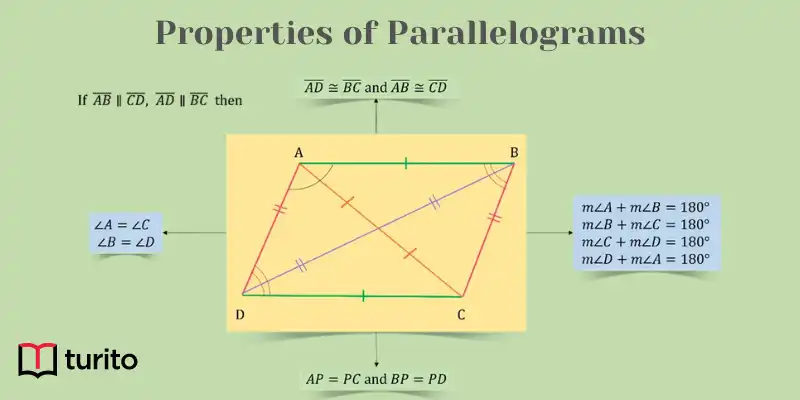Key Concepts
- Define a parallelogram.
- Find the relation between measures of sides of a parallelogram.
- Find the relation between the angles of a parallelogram.
- Explain other properties of parallelogram.
Parallelogram
A quadrilateral whose two pairs of opposite sides are parallel is called a parallelogram.

Theorem
If a quadrilateral is a Properties of parallelograms, then its opposite sides are congruent.

Proof: In △DCA and △BAC,
∠1=∠3
AC=AC [Reflexive property]
∠2=∠4
Then,
△DCA≅ △BAC by Angle-Side-Angle congruence criterion.
If two triangles are congruent, their corresponding sides are equal.
So, AD− = BC−and AB− = CD−.
Theorem
If a quadrilateral is a parallelogram, then its consecutive angles are supplementary.

If
AB− ∥ CD−, AD− ∥ BC−
then
m∠A+m∠B=180°
m∠B+m∠C=180°
m∠C+m∠D=180°
m∠D+m∠A=180°
Proof: The angles ∠A and ∠B are the consecutive interior angles formed when parallel lines
AB− and CD− are intersected by transversal AD−.
We know that when two parallel lines are intersected by a transversal, the consecutive interior angles formed are supplementary.
So, ∠A+∠B=180°
Theorem
If a quadrilateral is a parallelogram, then opposite angles are congruent.

Proof: The angles ∠1 and ∠2 are the consecutive interior angles formed when parallel lines
PQ− and SR− are intersected by transversal PS−.
We know that when two parallel lines are intersected by a transversal, the consecutive interior angles formed are supplementary.
So, ∠1+∠2=180° …(1)
The angles ∠2 and ∠3 are the consecutive interior angles formed when parallel lines PS− and QR− are intersected by the transversal SR−
Therefore, ∠2 + ∠3 = 180° …(2)
From (1) and (2), we get,
∠1 + ∠2 = ∠2 + ∠3
∠1 = ∠3
So, opposite angles are equal.
Theorem
If a quadrilateral is a parallelogram, then its diagonals bisect each other.

Proof: In △PXS and △RXQ
∠1=∠3 [Consecutive interior angles formed when PS- and QR−are intersected by PR-]
PS=QR [If a quadrilateral is a parallelogram, then its opposite sides are congruent]
∠2=∠4 [Consecutive interior angles formed when PS- and QR− are intersected by QS−]
So, △PXS≅ △RXQ by Angle-Side-Angle criterion.
We know that if two triangles are congruent, their corresponding sides are equal.
Since △PXS≅ △RXQ then PX=XR and QX=XS
Exercise
- Find the length of BC.

- In parallelogram WXYZ, find the measure of

- Find the measure of

- Find the perimeter of the parallelogram.

- What is the angle measure of the point at the bottom?

Concept Map

What we have learned
- A quadrilateral whose two pairs of opposite sides are parallel is called a parallelogram.
- If a quadrilateral is a parallelogram, then its opposite sides are congruent.
- If a quadrilateral is a parallelogram, then its consecutive angles are supplementary.
- If a quadrilateral is a parallelogram, then opposite angles are congruent.
- If a quadrilateral is a parallelogram, then its diagonals bisect each other.

Related topics
Addition and Multiplication Using Counters & Bar-Diagrams
Introduction: We can find the solution to the word problem by solving it. Here, in this topic, we can use 3 methods to find the solution. 1. Add using counters 2. Use factors to get the product 3. Write equations to find the unknown. Addition Equation: 8+8+8 =? Multiplication equation: 3×8=? Example 1: Andrew has […]
Read More >>Dilation: Definitions, Characteristics, and Similarities
Understanding Dilation A dilation is a transformation that produces an image that is of the same shape and different sizes. Dilation that creates a larger image is called enlargement. Describing Dilation Dilation of Scale Factor 2 The following figure undergoes a dilation with a scale factor of 2 giving an image A’ (2, 4), B’ […]
Read More >>How to Write and Interpret Numerical Expressions?
Write numerical expressions What is the Meaning of Numerical Expression? A numerical expression is a combination of numbers and integers using basic operations such as addition, subtraction, multiplication, or division. The word PEMDAS stands for: P → Parentheses E → Exponents M → Multiplication D → Division A → Addition S → Subtraction Some examples […]
Read More >>System of Linear Inequalities and Equations
Introduction: Systems of Linear Inequalities: A system of linear inequalities is a set of two or more linear inequalities in the same variables. The following example illustrates this, y < x + 2…………..Inequality 1 y ≥ 2x − 1…………Inequality 2 Solution of a System of Linear Inequalities: A solution of a system of linear inequalities […]
Read More >>Other topics







Comments: